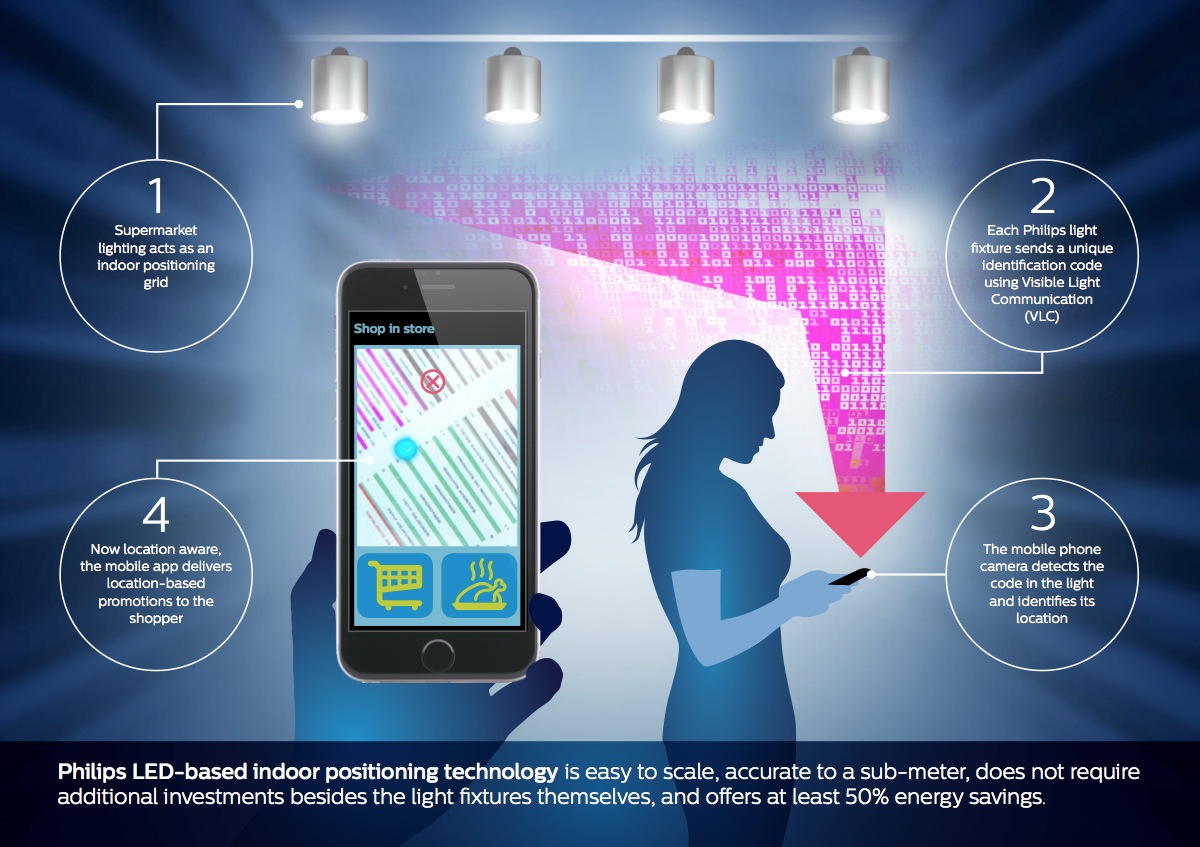Philips sheds light on the indoor positioning system hitting Australian retailers soon
Share
Gerben van der Lugt, global head of indoor positioning at Philips Lighting, speaks to Marketing about how connected lighting can be used as a positioning system for retailers and why it’s better than beacons.
 Gerben van der Lugt leads the indoor positioning business for Philips Lighting based out of the company’s Amsterdam headquarters. The unit is part of what’s called the Global System Team. It’s a group dedicated to innovating for retailers, trying to solve the everyday needs of retailers.
Gerben van der Lugt leads the indoor positioning business for Philips Lighting based out of the company’s Amsterdam headquarters. The unit is part of what’s called the Global System Team. It’s a group dedicated to innovating for retailers, trying to solve the everyday needs of retailers.
For the past 120 years, that was mostly around energy savings, as well as improving store ambience. But in the last five years, lighting like so many other things, has been connected to the web and become part of the internet of things, creating many more possibilities.
The innovation agenda for Philips Lighting largely revolves around how lighting can provide value beyond illumination.
Van der Lugt’s team found that one of the things lights can do is act as an indoor positioning platform. This topic of indoor location is of growing interest with retailers as they try to seamlessly integrate the different channels – websites, mobile apps, physical stores – they operate.
Imagine you’re walking through a department store. Every single light fitting is connected back to software that knows exactly where it’s located. Each of those fixtures is emitting light in a unique pattern indistinguishable to the human eye, but any smartphone with a camera and the Philips SDK can interpret it. As opposed to using Bluetooth to detect proximity, this method determine the user’s exact positioning in the store.
Marketing spoke to van der Lugt while in Australia for the Retail Leaders Forum.
Marketing: When you talk about helping retailers, what kind of retail store types are you talking about?
Gerben van der Lugt: Typically, from a lighting perspective, we basically have a broad scope when it comes to retail. I think we have strong propositions for, let’s say, ‘big box’ retail or large format retail. That includes electronic, DIY, others as well. Also, pretty strong propositions for fashion retail. Yesterday at the conference I was actually showing a few of our latest innovations that were basically focussed on large format as well as on fashion retail.
One of the examples I gave was the dynamic shop window, which basically provides spectacle in the shop window, so people get attracted, and foot-flow gets increased for fashion retail.
M: Talk me through the customer or shopper experience. Is it them interacting with things. Is it wholly utility in terms of finding their way around? You mentioned dynamic shop fronts, so it’s part utility part engagement?
GvdL: Yesterday I presented our story at the retail leaders forum, showing a piece of research we had done, we interviewed 3000 shoppers across different markets – US, France and the Netherlands – in different segments as well – DIY and grocery shopping – and basically asked ‘what if your retailer would add location based services to its mobile app? Would you like using that?’
There were two important outcomes. One was, we found that the current use of mobile apps with retailers is still very limited, although, strong usage in the US with 50%. In Europe we have numbers around 20-30%. While the intention of shoppers to use mobile apps that are enhanced with location based services was around 50-60%.
So, there is a real potential for retailers to drive the usage of their applications, if they enhance it with location based services.
The second question we asked shoppers is ‘what type of service would you like?’
We tested 26 users, we found that the type of use cases that they really like are varied.
One would be product search, which is the most obvious one, I think, also the most documented. Typically, if you have a store, if you have a shopping list, you basically know where to find 90% of those items because you shop for them regularly, but then there’s this famous last item on your shopping list that you simply can’t find. Basically what happens today is you either go out and look for a sales associate to help you, and you find them, you take them back and he actually explains where the product is, it happens to be close to where you’re looking for it.
Wouldn’t it be great if you could just go to your mobile app, type it in from the catalogue and ask where it is.
That’s one of the use cases, another one would be, indeed like you said, is customer engagement. Interacting with the customer. Based on where they are in the store. Why would you not send somebody the weekly promotion on wines, if they are in the wine section, so they can act on it. You know they are actually ready to buy – they’re in the wine section for a reason.
This could drive conversion rates on promotions.
Those are typically examples that used location based in-store.
M: So the role of the lighting display is a two-in-one. It’s lighting in a grid, like a map of beacons in the store? Is that accurate?
GvdL: It’s close to accurate. Why would you not use that exact same infrastructure to also provide you with an indoor location platform?
The way we do it is by leveraging two technologies. The prime technology is what we call visible light communication (VLC). Basically, we provide a unique identifier to each fixture, and we send it out via the lights. We vary the intensity of the light, super-fast with minimal variations, so the human eye cannot see it. But if you look up with the camera on your phone, the camera could detect that code, so every light gets a unique identity.
That allows us to match the knowledge of which identifier belongs to which fixture, and where that is in the store, then re-calculate where you exactly are. And I mean exactly. It’s 30cm.
What it provides is, first, very stable positioning performance, super accurate, as well as no latency, or delay. It’s a real time positioning.
It also provides orientation. The phone knows where it’s looking at. You could turn the map. Like your car navigation, if you put your fixed map in your car navigation, sometimes it says turn left and on the map it means you have to turn right, which is very confusing for people. But that’s why most people choose not to have a fixed map, but an oriented map, so they’re always pointing up. That’s what we can do with the orientation on our system as well.
M: Are you competing against guys with beacon technology? Who are your competitors?
GvdL: Yes and no. In my view, most of the beacon providers are designed for proximity. It’s not a positioning technology, it’s a proximity technology. That’s where it’s designed for, so it provides use cases where I’m now close to, or further away, from a beacon. In some cases, this is perfect. If you are a small fashion shop and you just want to welcome people as they enter your shop, put a beacon at the entrance of your shop and welcome people with that. You don’t need a lighting system with that.
However, if you need accurate product-level positioning, in a large supermarket where people are searching for products then a beacon installation will not help you, simply because it does not have accurate positioning. Or you would need hundreds of beacons in one store. Most of those stores are part of a chain so they have to replicate that a few hundred times. It’s a nightmare in terms of installation.
That’s why we got such good traction at the Retail Leaders Forum as well. People understand it and want a positioning platform but also want it to be scalable and easy to install and maintain, so if we can use the lighting infrastructure for that, for which already we have the processes in place to design it and to install it and maintain it, that would actually be a double whammy.
M: Given that lighting is undergoing a revolution from a utility thing where you’d be speaking to facility managers or operations or whomever, who are you talking to now? Is it marketers? Digital or IT? The target market must be changing a lot for you.
GvdL: That’s the most exciting part, actually. That’s why for us, it was our first time at the forum, where we would typically find our new target group, which is marketing managers. It’s specifically digital marketing managers, or innovators, as well as IT.
In our view it’s the combination of three functions within retail that can make this happen. One is marketing, ‘how do we apply it and what is the value for shoppers?’, IT, in terms of getting the IT systems integrated to realise the value in a mobile application, and then obviously, facility and energy management to decide on the lighting.
M: How would this be built in to a retailers own app?
GvdL: What we provide is a software development kit (SDK), to the mobile application developers that work for the retailers. So, typically a retailer would choose to integrate this positioning functionality into its main app. We provide the means for that. We have simple advice that can be integrated by the app developers, we have a team that provides developer support if there are any questions. We are really set up to have this integrated into the retailer app.
M: What can we look forward to in Australia, are we going to see it soon?
G vd L: If it’s up to me, the answer is yes! We are now open for business in Australia. Products are available so we can deliver lighting systems that do have this capability. Our software is ready, our teams are trained in Australia. We used the event yesterday to launch it. We had very good traction. I’m here the remainder of the week to speak to quite a few retailers. Hopefully we’ll see the first application soon in Australia.
















